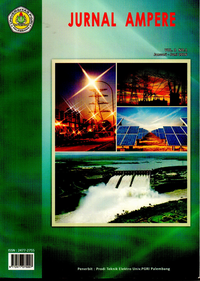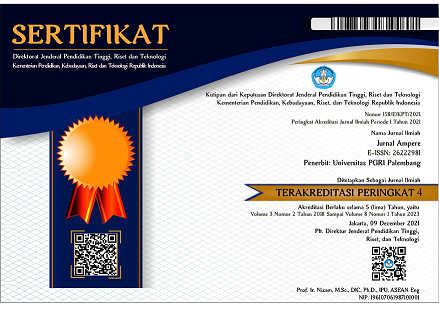NILAI EKONOMIS PENGGUNAAN SOLAR CELL TERHADAP GENSET SEBAGAI CATU DAYA PADA BASE TRANSCIEVER STATION (BTS) TELKOMSEL DI LOKASI KELAPA DUA KABUPATEN BANYUASIN
DOI:
https://doi.org/10.31851/ampere.v5i1.4309Keywords:
Kelapa Dua, Base Tranceiver Station (BTS), Genset, Solar Cell, Cost savingAbstract
Telecommunications and information are the most important part for urban and regional communities, to cover telecommunications services especially in the remote areas, waters and borders far from the city center, the need to build a BTS (base transceiver station) as communication access to communication signals and information. Lack and lack of electricity supply in this case PT. PLN, the Solar type of fuel oil in the waters and inland areas can still be relied upon as another energy source to supply electricity to the base transceiver station in the remote area by using a generator as a supply. Constraints by using generators include the difficulty of transportation and scarcity of diesel fuel, high diesel prices. To overcome this problem as an alternative that is using solar energy, or better known as solar cells that are environmentally friendly. With a total average solar light of 4,744 KwH / m2 so that the needs of the PV Module at BTS Kelapa Dua are required 40 series PV modules and 3 units of Solar Charge Controller. By using Solar Cell Panel a monthly fee of Rp. 20,000,000 is certainly more economical, so that the cost savings of generator operational costs with annual Saving costs obtained is Rp. 160,704,750.
ABSTRAK Telekomunikasi dan informasi merupakan bagian terpenting bagi masyarakat kota dan daerah, untuk mengcover layanan telekomunikasi khusunya didaerah pedalaman, perairan dan perbatasan yang jauh dari pusat kota, perlunya dibangun BTS (base transceiver station) sebagai akses komunikasi terhadap sinyal komunikasi dan informas. Kurangnya dan  ketiadaan pasokan energi listrik  dalam hal ini PT. PLN, maka Bahan Bakar Minyak jenis Solar diwilayah perairan dan pedalaman masih bisa diandalkan sebagai sumber energi lain untuk mensuplai listrik ke BTS (base transceiver station) di daerah terpencil tersebut yaitu dengan menggunakan genset sebagai catuan. Kendala dengan menggunakan genset diantaranya sulitnya transfortasi dan  kelangkaan solar, harga solar yang tingggi. Untuk mengatasi masalah tersebut sebagai alternatif lain yaitu menggunakan energi surya, atau lebih dikenal dengan sebutan solar cell yang ramah lingkungan. Dengan total rata-rata cahaya matahari sebesar 4,744 KwH/m2 sehingga kebutusan Modul PVdi BTS Kelapa Dua dibutuhkan Modul PV hubungan seri 40 buah dan Solar Charge Controller sebanyak 3 unit. Dengan menggunakan Panel Solar Cell biaya perbulan sebesar Rp. 20.000.000 tentunya lebih ekonomis, sehingga Cost saving terhadap biaya operasional genset  dengan Saving cost pertahun yang didapat sebesar  Rp. 160.704.750.
References
Junial H, Pengujian Sistem Pembangkit Listrik Tenaga Surya Solar Cell Kapasitas 50WP, 2010
Badaruddin, Sugiharto. Pemanfaatan Energi Matahari sebebagai Catu Daya pada Base Tranceiver Station (BTS) Makrocell, 2011 Universitas Mercu Buana
Chadidjah S, Wiyoto HI. Renewable Energy.2011 Genta Pustaka Jakarta
Supranto. Teknologi Tenaga Surya, 2015 Global Pustaka Utama Yogyakarta
http://www.esdm.go.id/berita/artikel/56-artikel/4034-solar-cell-sumber-energi-terbarukan-masa-depan
PT. United Tractors Tbk. (1993). Buku panduan Genset, Jakarta
Downloads
Published
How to Cite
Issue
Section
License

Jurnal Ampere is licensed under a Creative Commons Attribution-ShareAlike 4.0 International License.
Authors who publish with this journal agree to the following terms:
- Authors retain copyright and grant the journal right of first publication with the work simultaneously licensed under a Creative Commons Attribution License that allows others to share the work with an acknowledgement of the work's authorship and initial publication in this journal.
- Authors are able to enter into separate, additional contractual arrangements for the non-exclusive distribution of the journal's published version of the work (e.g., post it to an institutional repository or publish it in a book), with an acknowledgement of its initial publication in this journal.
- Authors are permitted and encouraged to post their work online (e.g., in institutional repositories or on their website) prior to and during the submission process, as it can lead to productive exchanges, as well as earlier and greater citation of published work.






